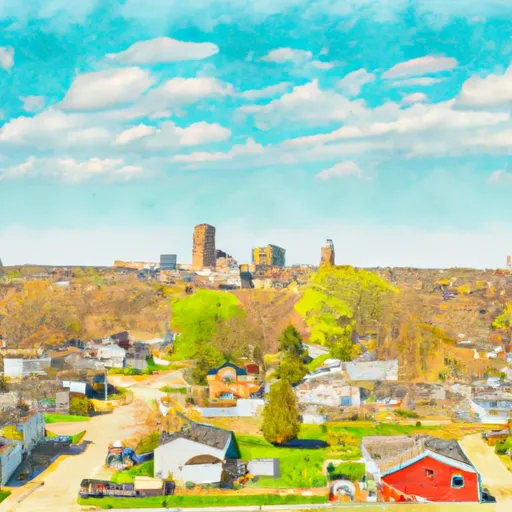-
 Snoflo Premium
Snoflo Premium
Get unlimited access to all our content
With no Ad interruptions! - Start Your Free Trial Login with existing account
Huntertown
Eden Index
Climate
8.0
•
Recreation
3.1
•
Community
4.0
•
Safeguard
5.3/10

Huntertown is a small town located in Allen County, Indiana. The climate in Huntertown is classified as humid continental, characterized by warm summers and cold winters. Average temperatures range from the mid-20s Fahrenheit in winter to the mid-80s in summer. Precipitation is fairly evenly distributed throughout the year, with an average annual rainfall of around 38 inches.
Hydrologically, Huntertown is situated near Cedar Creek, a tributary of the St. Joseph River. This provides opportunities for outdoor activities such as fishing, canoeing, and kayaking. The creek is known for its diverse fish population, including bass, catfish, and panfish. Additionally, the area is home to several parks and nature reserves, offering hiking trails, picnic areas, and wildlife observation.
Outdoor enthusiasts can explore the nearby Salomon Farm Park, which features walking trails, a community garden, and historical farm buildings. Another popular recreational spot is the Eel River Preserve, boasting scenic river views and opportunities for camping, birdwatching, and nature photography.
Overall, Huntertown's climate, hydrology constituents, and outdoor recreation opportunities make it an appealing destination for nature lovers and those seeking outdoor adventures.
What is the Eden Index?
The Snoflo Eden Index serves as a comprehensive rating system for regions, evaluating their desirability through a holistic assessment of climate health, outdoor recreation opportunities, and natural disaster risk, acknowledging the profound impact of these factors on livability and well-being.
Climate Health Indicator (CHI): 8.0
Huntertown receives approximately
972mm of rain per year,
with humidity levels near 82%
and air temperatures averaging around
10°C.
Huntertown has a plant hardyness factor of
6, meaning
plants and agriculture in this region thrive during a short period during spring and early summer. Most
plants will die off during the colder winter months.
By considering the ideal temperature range, reliable water supplies, clean air, and stable seasonal rain or snowpacks, the Climate Health Indicator (CHI) underscores the significance of a healthy climate as the foundation for quality living.
A healthy climate is paramount for ensuring a high quality of life and livability in a region, fostering both physical well-being and environmental harmony. This can be characterized by ideal temperatures, reliable access to water supplies, clean air, and consistent seasonal rain or snowpacks.
Weather Forecast
Streamflow Conditions
Western Lake Erie
Area Rivers
Western Lake Erie
Snowpack Depths
Western Lake Erie
Reservoir Storage Capacity
Western Lake Erie
Groundwater Levels
Recreational Opportunity Index (ROI): 3.1
The Recreational Opportunity Index (ROI) recognizes the value of outdoor recreational options, such as parks, hiking trails, camping sites, and fishing spots, while acknowledging that climate plays a pivotal role in ensuring the comfort and consistency of these experiences.
Access to outdoor recreational opportunities, encompassing activities such as parks, hiking, camping, and fishing, is crucial for overall well-being, and the climate plays a pivotal role in enabling and enhancing these experiences, ensuring that individuals can engage in nature-based activities comfortably and consistently.
Camping Areas
| Campground | Campsites | Reservations | Toilets | Showers | Elevation |
|---|---|---|---|---|---|
| Versailles State Park | 225 | 965 ft | |||
| Quakertown State Rec Area - Brookville Lake | 450 | 762 ft | |||
| Franklin County Park | None | 662 ft | |||
| Johnny Appleseed Park | 40 | 759 ft | |||
| Madison City Park | 35 | 450 ft | |||
| Mounds State Rec Area - Brookville Lake | 450 | 945 ft | |||
| Paul Ogle Riverfront Park | None | 451 ft | |||
| General Butler State Park | 110 | 490 ft | |||
| Ouabache State Park | 125 | 822 ft | |||
| Brookville Lake | 465 | 694 ft |
Nearby Ski Areas
Catastrophe Safeguard Index (CSI):
The Catastrophe Safeguard Index (CSI) recognizes that natural disaster risk, encompassing floods, fires, hurricanes, and tornadoes, can drastically affect safety and the overall appeal of an area.
The level of natural disaster risk in a region significantly affects safety and the overall livability, with climate change amplifying these risks by potentially increasing the frequency and intensity of events like floods, fires, hurricanes, and tornadoes, thereby posing substantial challenges to community resilience and well-being.
Community Resilience Indicator (CRI): 4.0
The Community Resilience Indicator (CRI) recognizes that education, healthcare, and socioeconomics are crucial to the well-being of a region. The CRI acknowledges the profound impact of these elements on residents' overall quality of life. By evaluating educational resources, healthcare accessibility, and economic inclusivity, the index captures the essential aspects that contribute to a thriving community, fostering resident satisfaction, equity, and social cohesion.

